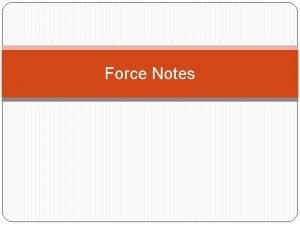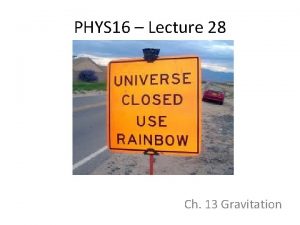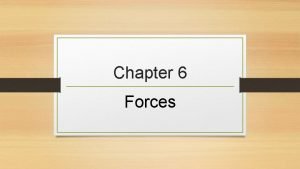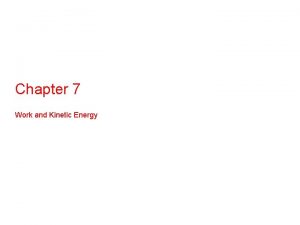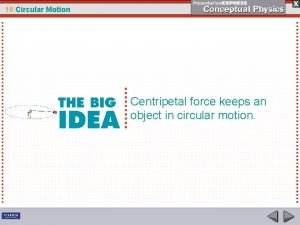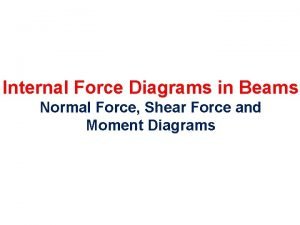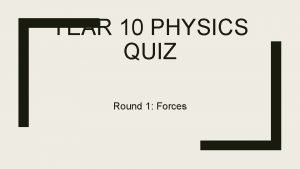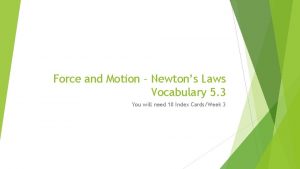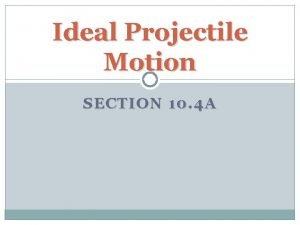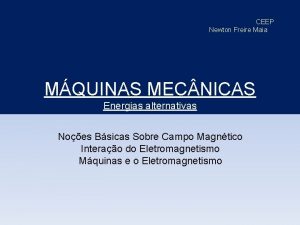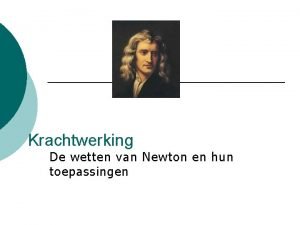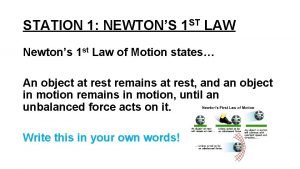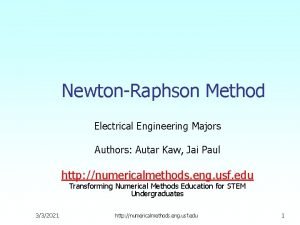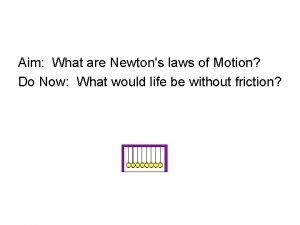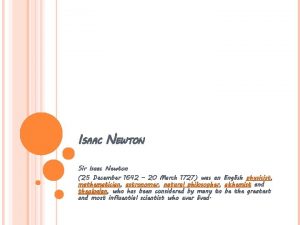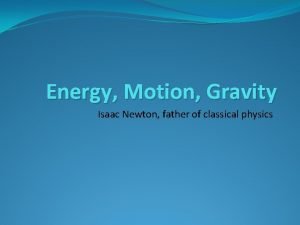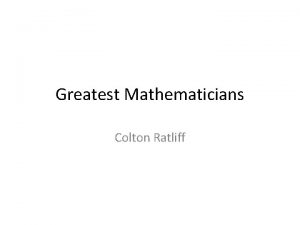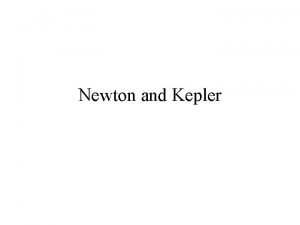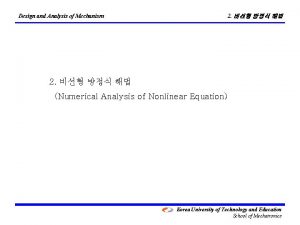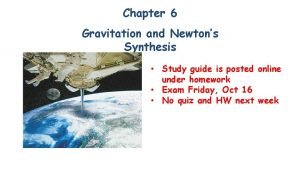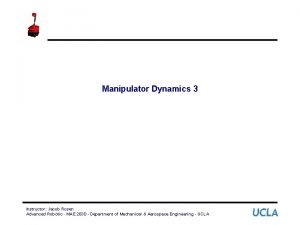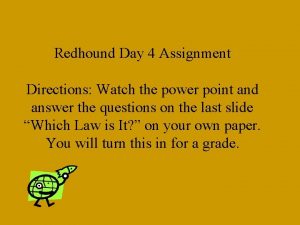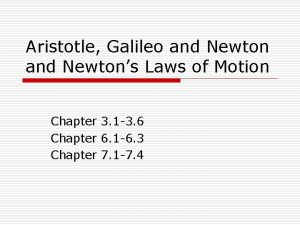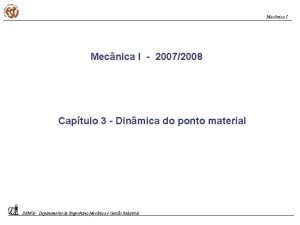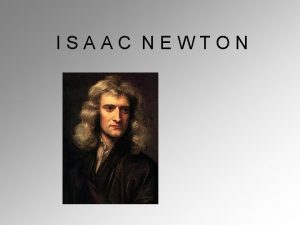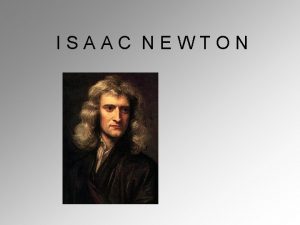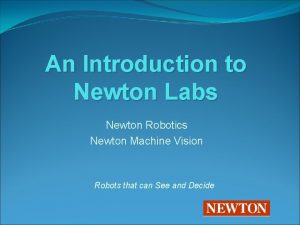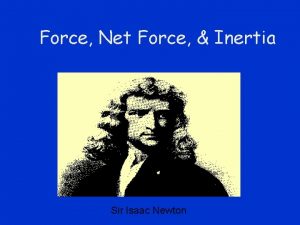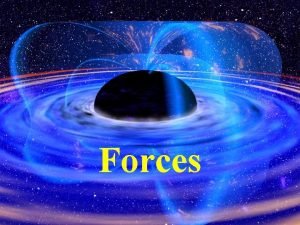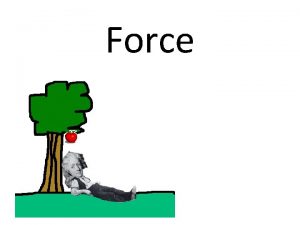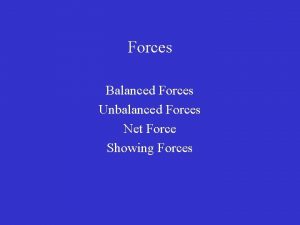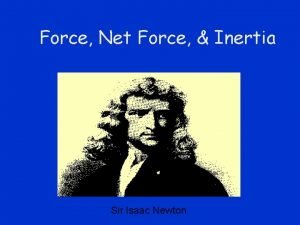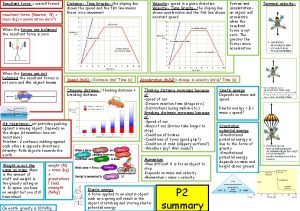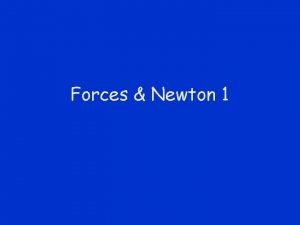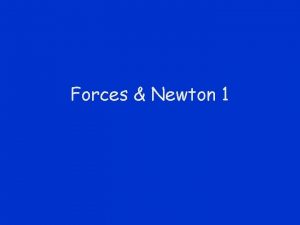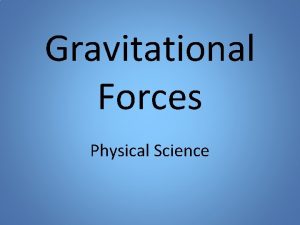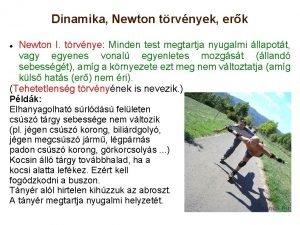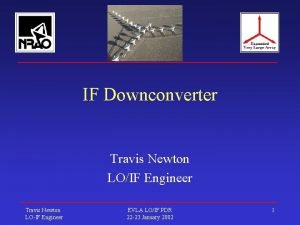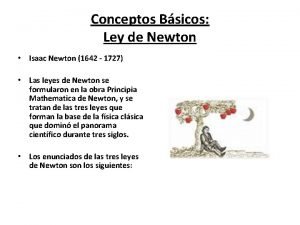Forces 9 22 08 Forces Force Newton N
























































- Slides: 56

Forces 9 -22 -08

Forces Force Newton (N) A push or a pull with size and direction Ex: 5 N n Unit used to measure force (equivalent to 0. 22 lbs of force, or 1 N can accelerate a mass of 1 kg at the rate of 1 m/s/s) n

Force and Motion n Balanced Force n n When 2 equal forces are exerted on an object and no change in motion results (this can mean no motion or constant velocity) Ex: 200 N

Unbalanced Force n n When 2 unequal forces are exerted on an object and a change in velocity (acceleration) results. This could mean a change in direction or speed.

Net force n The combination of forces. When forces are going in the same direction they are added, when they are opposing directions they are subtracted. (The net force will tell you if an object is in motion) Ex: 5 N 2 N n Net force =3 N to the right n

Try these: n 1. 10 N n 2. n 3. 15 N 4 N 3 N 2 N 5 N 2 N

Newton’s 3 laws of motion n Newton’s First Law of Motion n An object at rest will stay at rest, and an object in motion will stay in motion; unless acted upon by an outside force

Inertia n The tendency of an object to resist a change in motion. This is mass related. mass, inertia

Newton’s 2 nd law of motion a= F m The acceleration of an object depends on the mass of the object and the amount of force applied to it. As Force acceleration w/constant mass As mass acceleration w/constant force Note: 1 N = 1 kg x m/s/s n

Newton’s 3 rd law n n n For every action there is an equal and opposite reaction Forces come in pairs: action, reaction Forces are acting on 2 different objects Forces are equal in size Forces are immediate interaction

Examples 1. You push against the wall Action: You push on the wall Reaction: The wall pushes on you 2. You sit on your seat Action: You sit on the seat Reaction: The seat sits on you (ha ha) The seat pushes back up on you n

Examples of the 3 rd law n 1. A high speed bus and an unfortunate bug have a head-on collision. The force of the bus on the bug splatters it all over the windshield. Is the corresponding force of the bus greater than, less than, or the same as the force of the bug on the bus? IS the resulting deceleration of the bus the same as the bug?

Last one together…. . n A cannon recoils a few feet after shooting a cannonball 300 ft. What is the action, reaction? Do the cannon and cannonball interact with equal force?

Friction n A force that opposes motion (It always goes in the OPPOSITE direction of motion)

Causes of friction n Friction is caused by microscopic hills and valleys of one surface that catch onto the hills and valleys of another surface

Types of friction Sliding n Static n Rolling n Fluid n Occurs between 2 objects that rub surfaces Occurs between 2 surfaces in contact and keeps an object in place Occurs between the wheels of an object and a surface or when an object rolls Gas or liquid friction, air resistance

Friction between different surfaces n n n The level of friction that different materials exhibit is measured by the coefficient of friction. The formula is µ = f / N µ=coefficient of friction (how much friction occurs between 2 surfaces, ratio f = force of friction, N = normal force (N= mg)

What type of friction is the rock experiencing in each picture?

What type of friction is present ? n n On a person’s skateboard and the road On a sofa resting on the carpet On a person parachuting from a plane On a box being pushed along the ground

Gravity n n n The force of attraction between 2 masses (anything with mass pulls on each other) Gravitational force increases as mass increases Gravitational force decreases as distance between objects increase F=1/d 2


Mass vs. Weight n n Mass – the measure of the amount of matter in an object Weight – The measure of gravitational force of an object w= m*g, measured in Newtons Weight changes, mass does not

Determine your weight on earth w=m*g n m=your mass in kg n g= 9. 81 m/s/s n Example 60 kg * 9. 81 m/s/s = 600 N n

Your weight on other planets If the g-force is 1. 0 on the surface of Earth, the g-forces on the surfaces of the planets are: n Mercury = 0. 38 n Venus = 0. 91 n Earth = 1. 0 n Mars = 0. 38 n Jupiter = 2. 6 n Saturn = 1. 1 n Uranus = 0. 90 n Neptune = 1. 1 n Pluto = 0. 07 Multiply your weight by one of the factors above. n

n n Universal Gravitational constant = 6. 67 x 10 -11 If masses are large the force of gravity is large If the distances between objects are large the force of gravity weakens

Example problem n n n Here is a problem which envisions an unfortunate astronaut stranded exactly half way between the earth and moon. What is the gravitational force of the earth acting on him? The data we need are The mass of the astronaut: m 1 = 100 kg The mass of the earth: m 2 = 6 x 1024 kg The distance between earth and moon: r = 3. 8 x 108 m The universal gravitational constant: G = 6. 67 x 10 -11 N kg m 2/kg 2

How does gravity “work” ?

Acceleration due to gravity n n On earth it is 9. 81 m/s/s In free fall (no air resistance) all things will fall at the same acceleration Because of air resistance things will not fall at the same rate Objects that are bigger (more mass) will fall at the same rate as small objects due to Newton’s 2 nd law- more force

2 nd law explains same acceleration

n n Terminal velocity – As acceleration increases so does air resistance, until both forces are equal and the object is falling at constant velocity v = g*t

V=gxt n n v = velocity g = 9. 81 m/s/s t = time Example : A boy looking out a window from his apartment on the 4 th floor of the building decides to drop a water balloon on an unsuspecting person below. Four seconds later he hears a splat. How fast was the balloon going when it hit the pavement below?

Projectile motion n Question: Will gravity accelerate 2 balls that are released at the same time at the same rate (9. 81 m/s/s) if one is released down and the other is thrown out?

n n n v=gxt v = 9. 81 m/s/s x 4 s v = 39. 24 m/s

Projectile motion n A projectile (anything that is thrown or launched) has 2 motion components that are independent of each other 1. Vertical motion – gravity pulls on all objects with the same rate of acceleration 9. 81 m/s/s Horizontal motion – constant velocity if no air resistance

What would happen? n n A hunter spies a monkey in a tree, takes aim, and fires. At the moment the bullet leaves the gun the monkey lets go of the tree branch and drops straight down. How should the hunter aim to hit the monkey? Aim directly at the monkey Aim high (over the monkey's head) Aim low (below the monkey)

Elastic Forces n n Tension – Force that stretches (Like stretching a slinky) Compression – Force that squeezes (like squeezing a sponge)

n Cantilever

Bridges n n Bridges operate using forces of tension and compression Ex: Suspension Bridge

Longest bridge

Momentum n n A characteristic of a moving object that has to do with its mass and velocity The quantity of motion Law of conservation of momentum says that momentum is conserved in the absence of outside forces (it can be transferred) Momentum = mass x velocity

What is the momentum? n n n Which has more momentum? A 3 kg sledgehammer swung at 1. 5 m/s or a 4 kg sledgehammer swung at 0. 9 m/s? What is the momentum of a bird with a mass of 0. 018 kg flying at 15 m/s? Which has more momentum? A golf ball travels at 16 m/s while a baseball moves at 7 m/s. The mass of the golf ball is 0. 045 kg and the baseball is 0. 14 kg.

Angular momentum

Pressure!!!!! Pressure is how much force is applied over a certain area n Pressure = Force Area Unit = pascal or N/m 2 n

Fluid Pressure n n Fluids – Liquids or gases Fluid pressure is caused by the force of particles colliding with a surface Air pressure – Depends on elevation Sea level pressure is 14. 7 lbf per square inch on your body

Pressure n Fluids will move from an area of higher pressure to lower pressure to achieve equilibrium

Bernoulli’s Principle n n n Fast moving fluids exert less (static) pressure than do slow moving fluids http: //home. earthlink. net/~mmc 1919/v enturi. html Fast moving fluids exert less pressure since the molecules are “skimming” the surface

Lift n n Lift is an upward force on a solid object in a fluid Lift is created by differences in air velocities and pressure

Energy 1 -21 -09

Energy n n n What is energy and how is it different from matter? Matter is substance and energy the mover of substance Energy is the capacity to do work Energy cannot be created or destroyed (law of conservation of energy) Energy can change form

Types of energy n n n Chemical energy – in bonds between atoms and molecules Thermal energy or heat Electrical energy Potential energy Kinetic energy

Potential Energy n The energy in matter due to position or arrangement of parts. This is stored energy, because it has the potential to do work.

Gravitational potential energy n Work is done to elevate objects against the gravity of the earth. Energy is transferred from the person and stored in the ball The work done on the ball gives the ball gravitational potential energy. Gravitational potential energy = mgh Ball =1 kg, g=9. 81 m/s/s h=3 m Potential Energy = 30 Joules

Kinetic Energy n n n The energy of motion. Potential energy changes form to kinetic energy. The work done in lifting the mass gave the mass gravitational potential energy. Potential energy then becomes kinetic energy. Kinetic energy then does work to push stake into ground.

Kinetic Energy continued… n Kinetic Energy = ½ mass x speed 2

Sample Problem What is the kinetic energy of a 45 kg object moving at 13 m/sec? 1. First we identify the information we are given in the problem: • mass = 45 kg • velocity = 13 m/sec 2. Next, we place this information into the kinetic energy formula: • KE = 1/2 mv 2 • KE = 1/2 (45 kg)(13 m/sec)2 3. Solving the equation gives a kinetic energy value of 3802. 5 Joules

Roller Coasters, PE and KE http: //www. teachersdomain. org/resource /hew 06. sci. phys. maf. rollercoaster/ http: //www. teachersdomain. org/resource /phy 03. sci. phys. mfe. zcoaster/
 Amazing grace john newton letra español
Amazing grace john newton letra español A 400 newton girl standing on a dock
A 400 newton girl standing on a dock Centripetal force and gravitational force
Centripetal force and gravitational force Long range force vs contact force
Long range force vs contact force Centrifugal force in india
Centrifugal force in india Hooke's law vector form
Hooke's law vector form If you whirl a tin can on the end of a string
If you whirl a tin can on the end of a string Is gravity a noncontact force
Is gravity a noncontact force Contact vs noncontact forces
Contact vs noncontact forces Draw the shear and moment diagrams
Draw the shear and moment diagrams How does mechanical advantage work
How does mechanical advantage work Is electric force a conservative force
Is electric force a conservative force What force provides centripetal force
What force provides centripetal force Net force
Net force Which of the following forces is a contact force? *
Which of the following forces is a contact force? * Physics free body diagram
Physics free body diagram Constructive forces examples
Constructive forces examples Like parallel force system
Like parallel force system Intramolecular forces vs intermolecular forces
Intramolecular forces vs intermolecular forces The forces shown above are pushing/pulling forces
The forces shown above are pushing/pulling forces What are some contact forces and some noncontact forces?
What are some contact forces and some noncontact forces? Intermolecular vs intramolecular forces
Intermolecular vs intramolecular forces Unbalanced force
Unbalanced force Interu
Interu Newton's laws vocabulary
Newton's laws vocabulary Time of flight formula
Time of flight formula Newton's first law vocabulary
Newton's first law vocabulary Isaac newton color wheel
Isaac newton color wheel Newtons laws of gravity
Newtons laws of gravity Ceep newton freire maia
Ceep newton freire maia Georgina newton
Georgina newton Newton's three laws
Newton's three laws 3 wetten van newton
3 wetten van newton Newton first law
Newton first law Newton raphson method electrical engineering
Newton raphson method electrical engineering What did isaac newton do in the scientific revolution
What did isaac newton do in the scientific revolution Newton's law of motion
Newton's law of motion Newton 25
Newton 25 Newton
Newton Http://fabpedigree.com/james/mathmen.htm
Http://fabpedigree.com/james/mathmen.htm Isaac newton
Isaac newton Newton's laws comic strip
Newton's laws comic strip 비선형 연립방정식 newton-raphson
비선형 연립방정식 newton-raphson Gravitation and newton's synthesis
Gravitation and newton's synthesis Legea atractiei universale
Legea atractiei universale Newton's third law
Newton's third law John newton gravity media
John newton gravity media 3 law of newton
3 law of newton Newton's first law and second law and third law
Newton's first law and second law and third law Newton's second law
Newton's second law Newton euler
Newton euler Sayısal analiz yer değiştirme yöntemi
Sayısal analiz yer değiştirme yöntemi Motion examples in everyday life
Motion examples in everyday life Aristotle galileo and newton ideas about motion
Aristotle galileo and newton ideas about motion Dinamika partikel hukum newton
Dinamika partikel hukum newton Tercera ley de newton
Tercera ley de newton Equilibrio estatico
Equilibrio estatico

